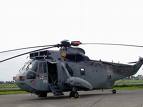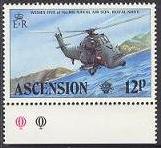|
Westland`s Wessex Mk.5
 In 1956, Westland, who held the license to build the American Sikorsky S-55, acquired the license for the more moderns-58. The powerplant of the latter was considered unsatisfactory and the British firm began a partial redesigning of the American aircraft to enable a 1,100hp Napier Gazelle NGa.11 turbine to be installed instead of the original 1,525hp Wright R-1820-84 radial. In 1956, Westland, who held the license to build the American Sikorsky S-55, acquired the license for the more moderns-58. The powerplant of the latter was considered unsatisfactory and the British firm began a partial redesigning of the American aircraft to enable a 1,100hp Napier Gazelle NGa.11 turbine to be installed instead of the original 1,525hp Wright R-1820-84 radial.
The Royal Navy immediately ordered the new Helicopter Anti Submarine (HAS) as the Wessex HAS Mk.1, to replace the older Whirlwind HAS Mk.7. The aircraft was basically similar to the Sikorsky S-58, but the nose profile was altered as a result of the installation of the turbine. Later Wessex (Mk.2 and 5) were powered by twin Rolls-Royce Gnome engines and employed as troop transports. Westland built 356 Wessex in all (including those for the civil market): the HAS Mk.1 version for the Royal Navy; the HC Mk.2 tactical transport version for the RAF; the HAS Mk.3 antisubmarine version with 1,550hp Gazelle NGa.18 turbine; the HU. Mk.5 for various roles on the Navy`s commando carriers.
As the Royal Navy`s first dedicated Anti Submarine Warfare (ASW) helicopter, the original version was the Wessex HAS.Mk 1, powered by a Napier (later on Rolls-Royce) Gazelle of 1,450hp, and this was supplanted by the Wessex HAS.Mk 3 version popularly called the Camel because of its humpbacked search radar above the rear fuselage.
These ASW versions had been replaced by Sea Kings at the start of Operation `Corporate` in April 1982, just two being sent to the war zone, XM837 aboard HMS Glasgow and XP142 aboard HMS Antrim, both assigned to No. 737 Squadron. The latter caught the Argentine submarine Santa Fe and crippled it with depth charges and machine-gun fire.
Specification Wessex HU.Mk 5:
Engines: one Rolls-Royce Coupled Gnome twin-turboshaft with two power sections each rated at l,350hp, but with combined output limited to 1,550hp
Weight, takeoff (lb/kg): 13,500/6,120
Rotor diameter (feet/meter): 56`0/17.07
Length (feet/meter): 65`9/20.03
Speed max. (knots/Km/h): 133/214
Range (miles/km): 478/769
Crew: 2 pilots + 1 observer + 1 Aircrew man
Armament: role kit can include two 7.62-mm (0.3-in) GPMGs firing ahead one or two 20-mm cannon, two or four AS.11 wire-guided missiles, or rocket pods.
Back to History Index
The Attack on the Argentinean submarine Santa FeOn the afternoon of April 24, 1982, during the Falkland Islands war, intelligence was received on board HMS Antrim, the ship commanding the South Georgian Task Group, which indicated that the Argentinean submarine ARA (Armada Republica Argentina) Santa Fe might be in the South Georgia area. The commander of the Task Group, Captain B. G. Young, ordered all ships - except HMS Endurance which was conducting separate operations in Hound Bay - to retire to the north east at 200 nautical miles in order to re-assess the situation. Further reports, indicating that the Santa Fe might attempt to enter Grytviken during the night of April 24-25, were received so it was decided to close the island again to a range of 50n/miles and to launch Antrim`s Wessex HAS.Mk 3 helicopter on a surface search at first light on April 25. Also, a Lynx from HMS Brilliant, which had joined the Task Group on April 14, to supplement depleted air assets as a result of the loss of two Wessex HU.Mk 5s which were lost on special operations on Fortuna Glacier, was tasked to conduct a surface search covering the coast towards Bird Island (to the north west), armed with a Mk 46 torpedo. HMS Plymouth`s Wasp helicopter was placed on stand-by armed with AS-12 missiles.
At 08:10 on April 25, Antrim`s Wessex, crewed by Lieutenant Commander Ian Stanley (1st pilot). Sub Lieutenant Stewart Cooper (2nd pilot). Lieutenant Chris Parry (Observer) and Petty Officer Aircrewman David Fitzgerald (Sonar Operator) launched and transited 50n/miles towards the mouth of Cumberland Bay. Visibility was less than 0.5n/m. A totally radio-silent transit was made and the area around Cumberland Bay was searched visually. One single sweep on the Wessex radar showed a tiny contact consistent with that of a submarine periscope at 08:55 bearing 350° from Barff Point at the mouth of the bay. The Wessex closed to investigate and at 0.5n/m the contact was visually identified as an Argentinean `Guppy III` class submarine.
The submarine was headed into sea, with no one immediately visible on the fin, and obviously preparing to dive. It was immediately attacked by Antrim`s Wessex using air-launched depth charges which exploded very close to the after port casing. After some violent careering the submarine turned hard to port and headed towards Grytviken, with oil smoke streaming from the after casing (hull). Plymouth was requested to launch her Wasp and Brilliant`s Lynx was called in to deliver her torpedo if submarine showed any sign of diving. But the Santa Fe showed little ability to dive. Brilliant`s Lynx, however, came under machine-gun fire from submarine. The torpedo was released, with nil result, and the machine-gun fire was returned until the arrival of Plymouth`s Wasp, which was meanwhile speeding in from 40 miles. On arrival, the Wasp fired two AS-12 missiles to prevent further gunfire attacks, or worse, from the submarine. Endurance announced that her Wasps (two) would be airborne shortly to deliver an AS-12 attack. Endurance Wasps subsequently achieved hits on the marine fin (conning tower) which did little damage as they punched through the GRP (Glass Reinforced Plastic) fin before exploding. The submarine subsequently abandoned alongside the British Antarctic Survey jetty in Grytviken harbour.
During the next day the submarine was moved from its berth at the B.A.S. jetty and was secured alongside the pier at the old whaling station at Grytviken. A party of engineers boarded the vessel before it finally sank, in order to assess the damage. The port shaft had sheared and the port engine had broken from its mountings from the blast of the depth charges. There were also numerous air and fuel-oil line fractures. The submarine slowly sank during the next 24 hours. Several weeks later it was refloated by a team of divers and was towed by MV Salvageman to a more convenient location and scuttled.
The importance of this action cannot be overstressed in the overall picture of the Falkland Islands conflict. The Santa Fe posed a considerable threat to any surface vessel. Indeed, when the torpedo tubes were inspected, the 21-in torpedoes therein were all armed, and the vessel`s log showed that she had already made a sighting on one of the ships in the Task Group. At that stage in the conflict, the loss of one of the Task Group would have been a morale-crippler for the British.
Back to History Index
 |
Ascension Is. |
1983 |
Wessex Mk.5, anti-submarine helicopter |
|